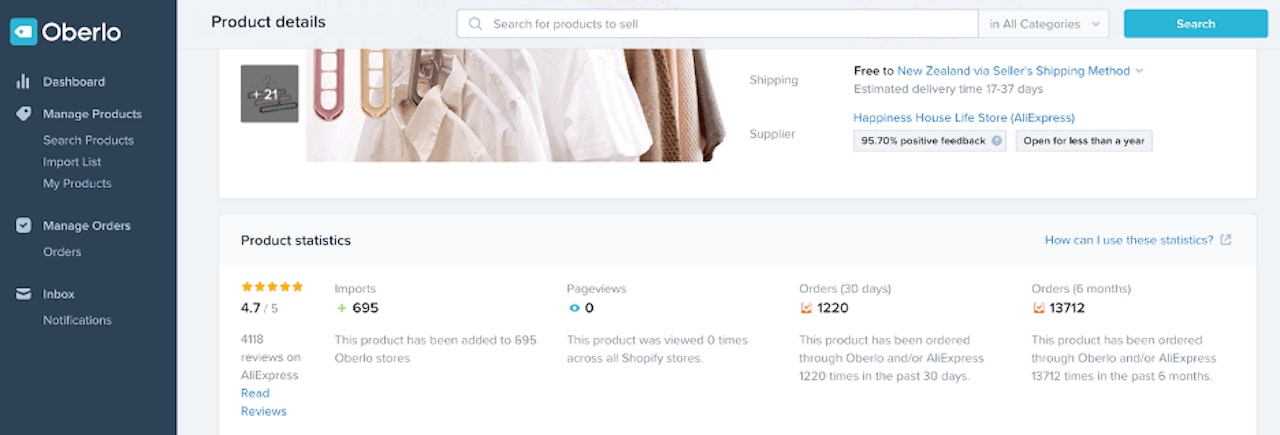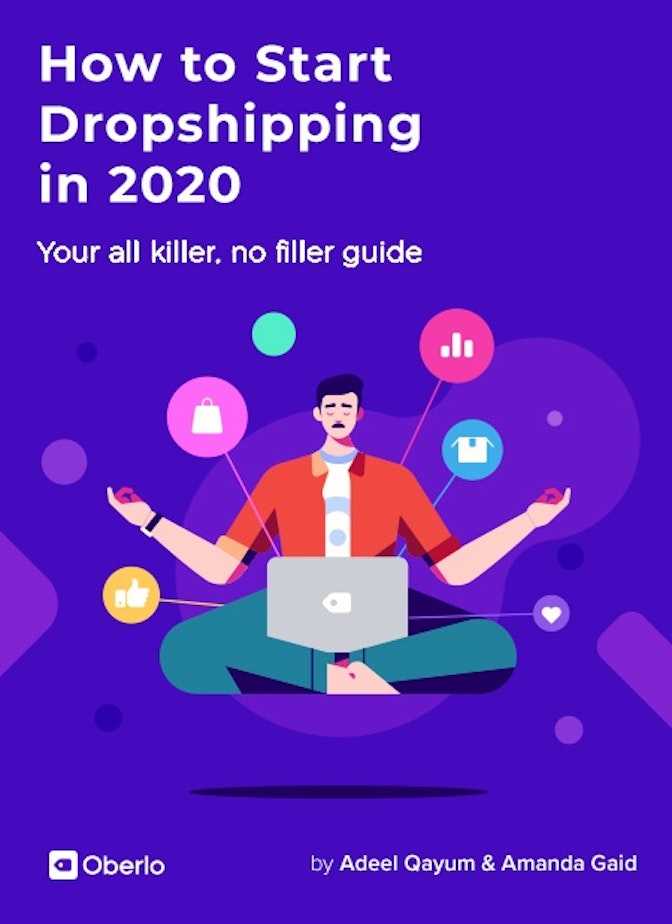Amanda here. A good store is nothing without good products, right? On top of that, you need to make sure that you have a strong relationship with high-performing suppliers. Since you won’t have total control over your products, it’s critical to have suppliers who are timely and have good business practices.
Trust me when I say choosing good products and suppliers will save you a whole lot of headaches in the future. They’ll also set you up for more success, faster. 💁♀️
There are three key elements for choosing a good product that will make and keep customers happy:
- The quality and demand of the product itself
- The reputation and practices of the supplier who ships it to your customers
- The shipping options to your customers
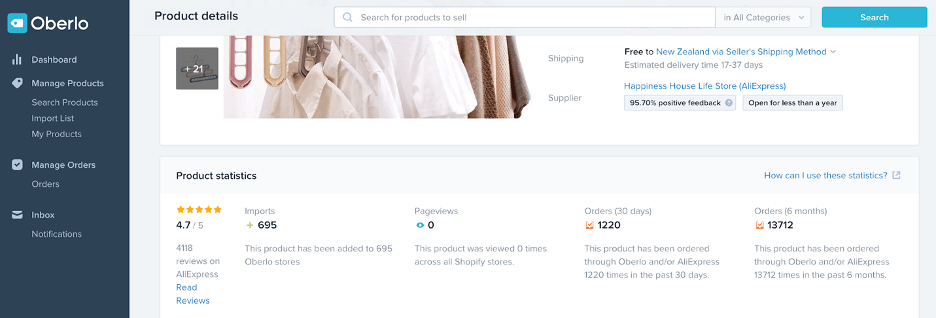
Let’s break these down.
| Product |
|
| Supplier |
|
| Shipping |
|
Now that you have the general guidelines, let’s look at the details of choosing killer products and stellar suppliers.



Your Secret Weapon: Oberlo Product Statistics
I want to get rid of some of the guesswork that comes with finding a product, and help you make data-driven decisions about which products are best for your business.
That’s what Oberlo Product Statistics are all about.
→ Click Here to Launch Your Online Business with Shopify
In the sections below, we’ll look at the data points that Oberlo has added, and explain how you can use them to find awesome products.
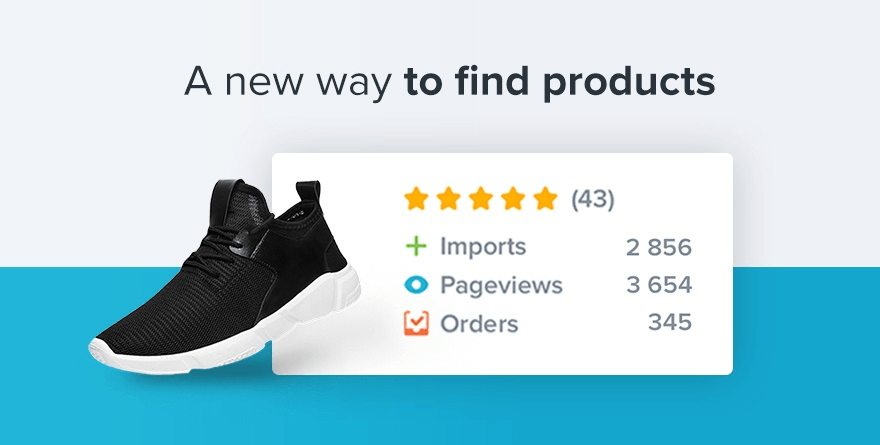
When you search for products in Oberlo, you see four product statistics for every product. They are:
- Star ratings and reviews count: What the average rating is out of five stars, and how many customers left a review on AliExpress. Look for products with high ratings and a lot of reviews – that’s how you know it’s a product that people really like. If you see a product without any reviews, it might be because it’s not sold on AliExpress, or because it’s new to Oberlo.
- Imports: The number of Oberlo merchants who have imported a product, or pulled a product into their store, in the past year. This number is more affected by what the dropshipper wants – in-demand, well reviewed products – than what the customer wants. This can tell you whether a product has already been discovered by other dropshippers, or whether it’s a diamond in the rough.
- Pageviews: The number of times a product has been viewed across all Shopify-powered stores in the past 30 days. Basically, pageviews reflect the amount of website visitors that merchants were able to bring to that product in their store.
- Orders: The number of times a product has been ordered through an Oberlo-powered store and through AliExpress in the past 30 days. When you click on a product and go to the product page, you can also see the six-month order statistics to see how well it has performed historically.
By themselves, these statistics are great info. But when you put them together, you can find awesome opportunities.
To show you how to do this, let’s look at four different categories of winning products:
- Hot Products
- Rising Stars
- High Potential Products
We’re going to look closer at each one, and how you can spot them using Oberlo Product Statistics.
Category #1: Hot Products
Look for products with:
- Over 500 orders in the past 30 days.
Orders are a pretty straightforward statistic: there’s no better sign that a product will sell than evidence that it’s sold before. Products with over 500 orders in the past 30 days already have a track record of success.
Because we combine Oberlo and AliExpress orders, if you see a product with lots of orders, you still have to test it in your store. That’s because you need to determine if the product is suitable for dropshipping or just selling well on AliExpress.
Here is an example of a Hot Product:
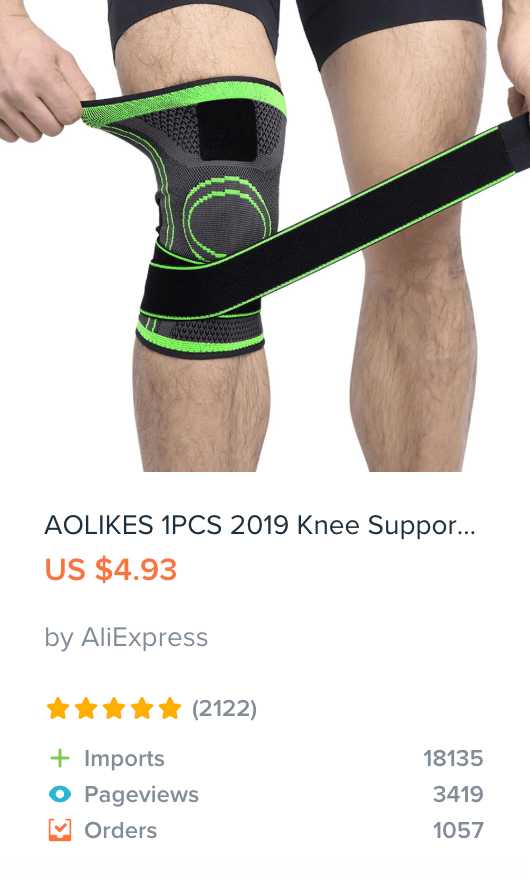
Category #2: Rising Stars
Look for products with:
- 100 to 500 orders in the past 30 days
- < 500 pageviews
Low pageviews aren’t necessarily bad! Rising Stars, which have low pageviews but a few orders, are products that are selling well despite limited web traffic. Jump on these products quickly so you can get ahead of the competition.
To take advantage of Rising Stars, ask yourself these questions:
-
- Is there a big difference between imports and pageviews? If imports are much higher than pageviews, many stores may have imported this product but few have been able to drive traffic to the product page. That signals an opportunity for hard-working marketers. If you’re willing to research and invest in marketing, you might be able to squeeze more sales out of this product.
- Are orders < 1 percent of pageviews? If the number of orders is less than 1 percent the number of pageviews, customers may have been interested in the product but turned off by other merchants’ product pages. To win those customers back, create a great product page. Pay special attention to product pictures: if they aren’t high-quality, take your own. And make sure to write epic product descriptions.
Here is an example of a Rising Star:
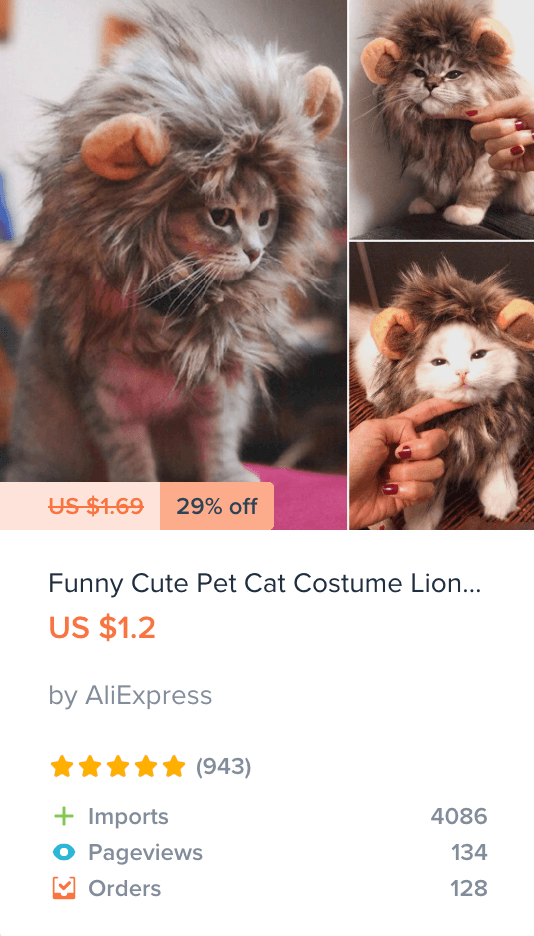
Category #3: High Potential Products
Look for products with:
- 50 to 500 orders in the past 30 days
- < 100 pageviews
- Multiple 5-star ratings, where available
Products with a few sales, low pageviews, and positive reviews (where available) fall somewhere between Rising Stars and Hidden Gems (below).
That’s why it’s really important to study the numbers. Go through the same questions listed for Rising Stars, above. In addition, ask:
- How many orders in the last six months? A product that had one sale in the past 30 days and a few dozen in the past six months may have more potential than meets the eye. These numbers could signal a steady-seller – which are good additions to any dropshipping store. Also keep in mind that a product that has had no sales in the past six months could be new to Oberlo.
- If it’s from AliExpress, are there reviews? If a product with these statistics is from AliExpress, look for 4- to 5-star reviews from more than one reviewer. High reviews, in combination with low imports and pageviews, may signal that a product is simply new to dropshipping.
Based on the criteria above, here is an example of a High Potential product:
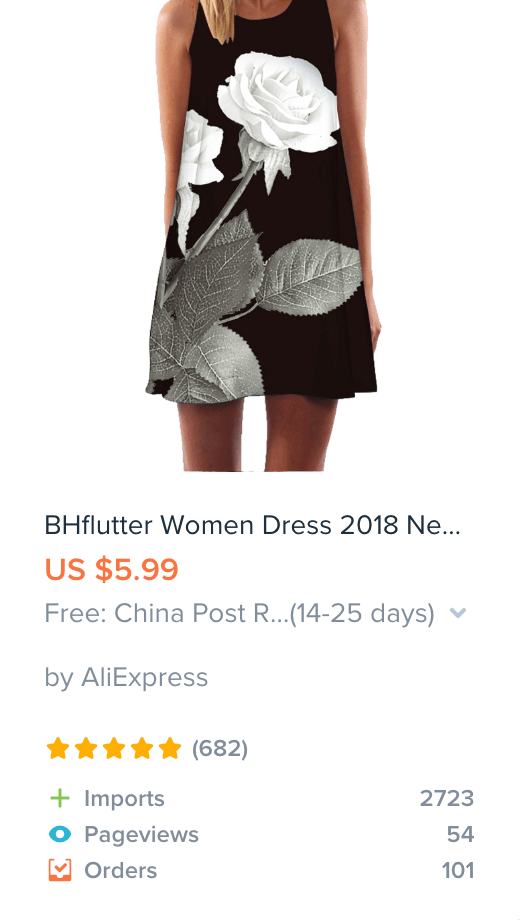
Searching on AliExpress
Before you start, download the Oberlo extension for the Chrome browser. If you don’t use Chrome, I recommend downloading it and using it for Oberlo.
To download the extension, click here from inside Chrome and then click the “Add to Chrome” button.

Now, when you go to AliExpress, you’ll see that many of the results have green boxes around them. That’s the extension telling you if the product has ePacket availability and how long the processing time takes for each order.
And when you hover your mouse over a product, you’ll see the blue Oberlo logo icon. When you click that, it will push the product to your import list automatically, so you can add it to your store.
| 📖 Ecommerce Dictionary
import list: In Oberlo, your import list shows all the items you want to add to your store. There, you can edit all the details, like the name, description, and photos. The import list acts like a ‘drafts’ folder meaning that no products will appear live until you manually push them to your store. |
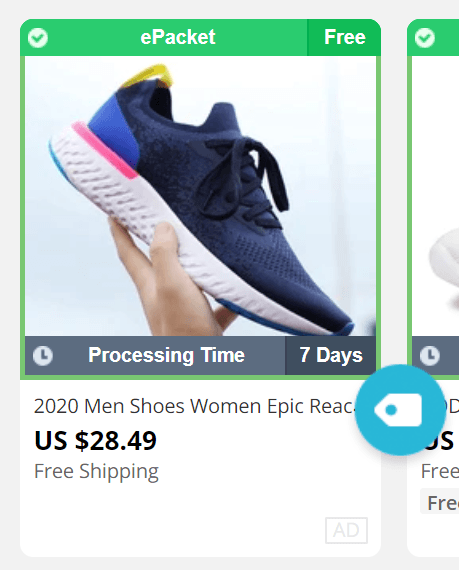
So let’s get back to the search results.
If you look at the first page of results, you’ll see a lot of information before you even click on a listing. Like:
- The product cost per piece (including any current sales)
- Shipping cost and ePacket availability
- The product’s rating, including how many people rated it
- How many people ordered it
If you sort by “Orders,” you can see products that have been ordered often and usually have good ratings.
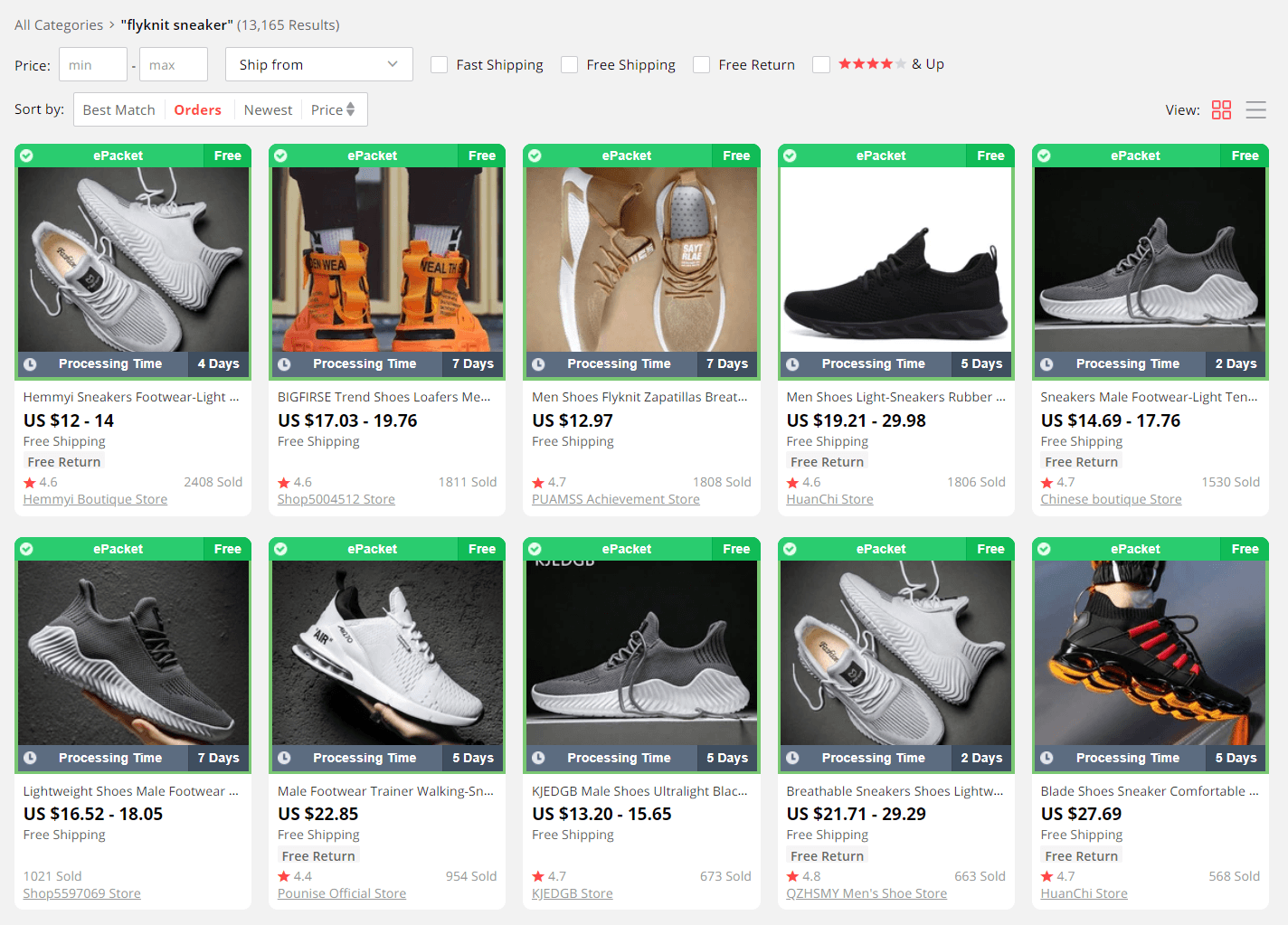
While these are quite solid, these strong numbers aren’t completely necessary. I would say that you’re good to go around 100 orders at a minimum and 4.8 stars or higher. Below 100 and you start playing with fire.
Let’s click a listing and see what we find.
At the top, you’ll see the supplier’s rating. Don’t bother with any supplier that’s rated lower than 95 percent. 🚫
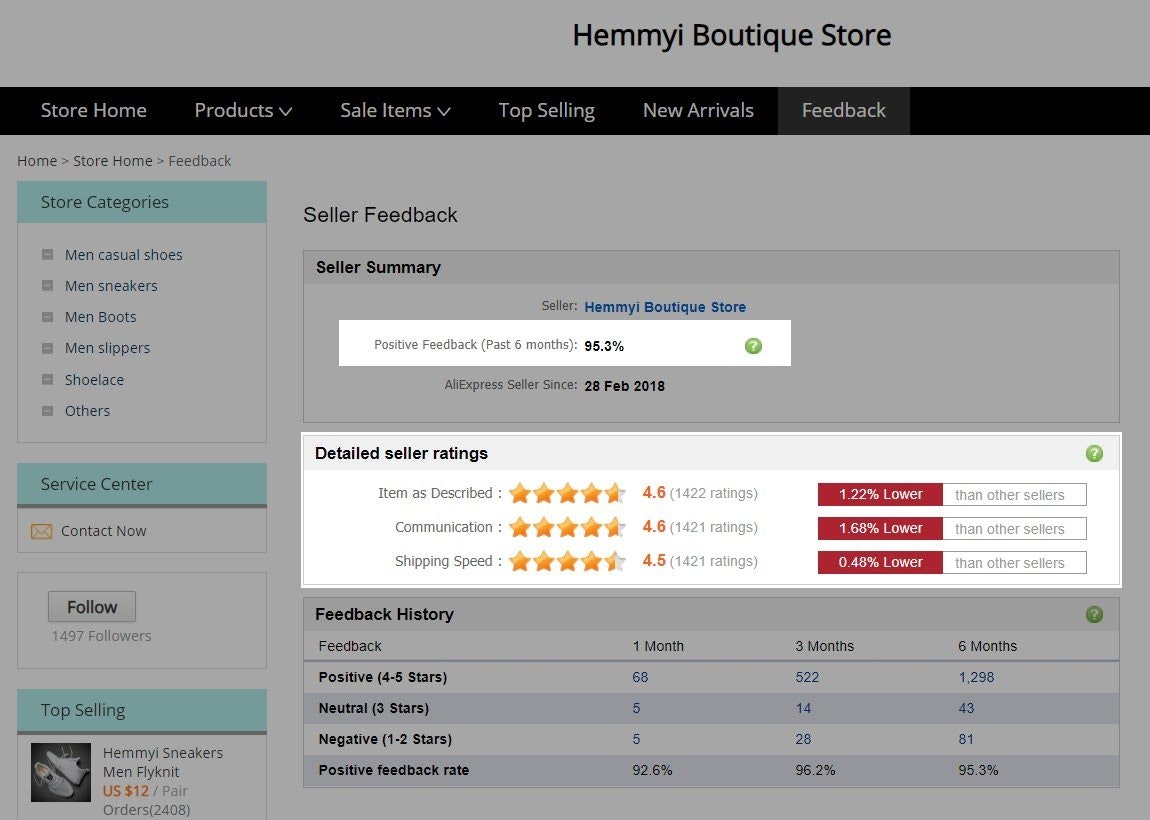
In the main section, you can see all the variations of a listing – like different styles and colors available.
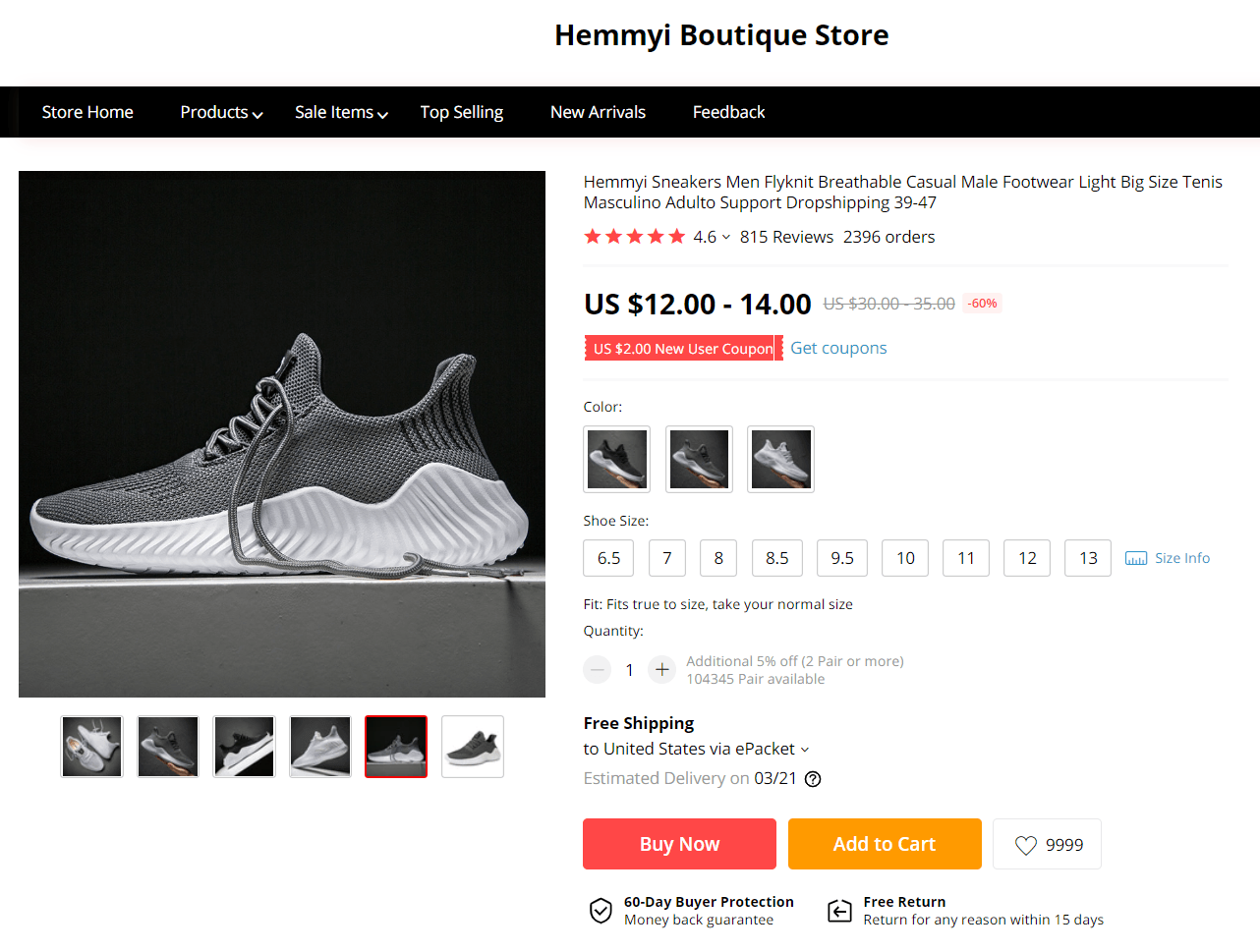
You’ll also be able to see the shipping options. Similar to Oberlo, just click the arrow and you can explore shipping options and prices for different countries.
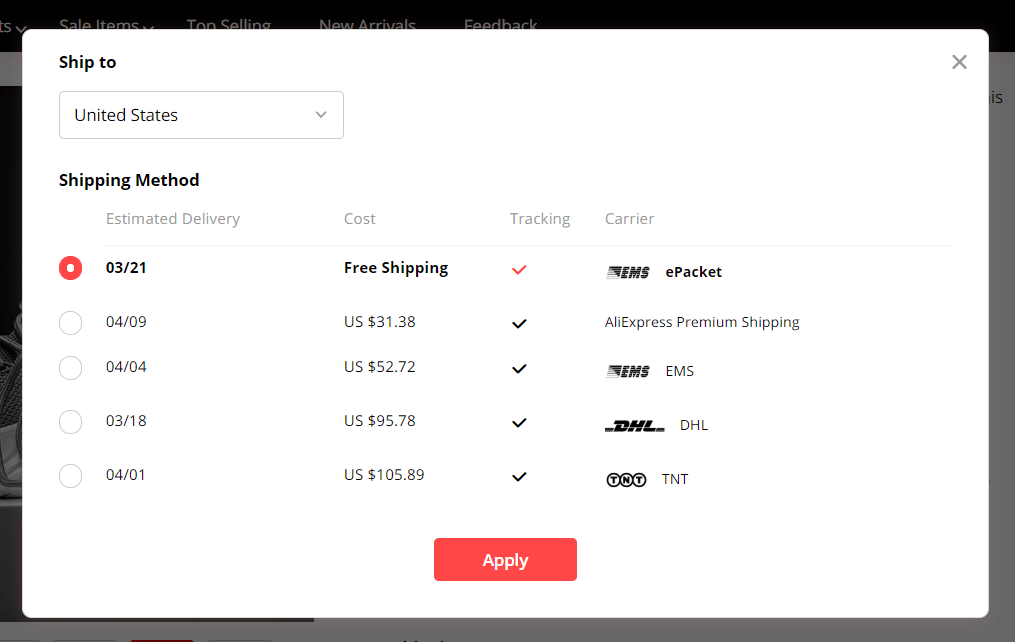
Then if you scroll down, you can see more details about the products as well as more photos.
| 🕒 Tip Time
If you use AliExpress, keep this in mind: at some point, they’ll put your credit card on hold and require you to verify your identity. You’ll need to submit a copy of a passport, driver’s license, or other identity card, as well as a photo of your credit card and a statement from that credit card. Don’t be alarmed – this is how AliExpress prevents fraud. Once you do this, it will take 1-3 business days to be verified. |
Choose Products with ePacket
By now, you’ve seen ePacket a few times in this book. It’s only fair that you finally find out what it is.
| 📖 Ecommerce Dictionary
ePacket: A shipping option offered by suppliers and merchants in China and Hong Kong. It allows for faster ePacket delivery of products coming from these countries to dozens of countries around the world. |
ePacket delivery is one of the most popular shipping methods offered by merchants from China and Hong Kong. For good reason – there are loads of benefits:
- It’s one of the fastest delivery options for international shipping. Other methods might take months to get to your customers, while ePacket averages about three weeks.
- It has lower shipping rates so you can keep your products lower to keep up with your competition.
- You have the ability to monitor your ePacket tracking numbers through companies like EMS and USPS – a huge benefit for your customer service abilities.
- You get free returns on any items that couldn’t be delivered.
Countries that Use ePacket
There are more than 40 countries that can get ePacket deliveries from China or Hong Kong suppliers. This means that you can use ePacket shipping for any of your customers who live in one of these countries:
|
Australia Austria Belgium Brazil Canada Denmark Finland France Germany Greece |
Hong Kong
Hungary Indonesia Ireland Israel Italy Japan Kazakhstan Korea Latvia |
Lithuania
Luxembourg Malaysia Malta Mexico Netherlands New Zealand Norway Poland Portugal Russia |
Saudi Arabia
Singapore Spain Sweden Switzerland Thailand Turkey Ukraine United Kingdom United States Vietnam |
ePacket Delivery Requirements
There are a few requirements for a product to qualify for ePacket:
- Weight: The package must weigh less than two kg (4.4 lbs).
- Value: The product cannot be worth more than $400 USD.
- Size: The package should be at least 14 cm long, but not longer than 60 cm on the longest side. If your item is smaller than 14 cm, the merchant will probably use a bigger box and add some filler material.
| 🕒 Tip Time
The moral of the story is: try to sell smaller items so that you can ship them with ePacket. This will save you a lot of money in the long run. Plus, the ability to track the item will probably save you a lot of customer service headaches too. |
Find Trustworthy Suppliers
Even if you already know which products you want to sell, and you’re sure that they’ll prove to be successful, you need to make sure that you find dropshipping suppliers that can provide the high-quality service that your business deserves.
You want to make sure your suppliers:
- Are easy to communicate with (this can be an issue if your suppliers are in Asia and don’t speak much English)
- Answer all of your messages in a timely manner, ideally in 24 hours or less
- Get your orders right the first time, so you don’t have to deal with a lot of customer complaints and returns
- Have good reviews from other people who have ordered items from them
Here are some tips for finding the right ones.
Research
You might need to choose whether to go with a domestic or overseas supplier depending on the number of suppliers in your chosen product niche. Look at things like:
- The types of raw materials they use to make their products
- Their delivery times, and whether they offer ePacket for items that are small enough
- Their customer service options, like whether they offer refunds for returned items
- How good their reviews are on Oberlo and/or AliExpress
Contact Them Before You Decide
Talk to the dropshipping supplier that suits your needs and start a relationship with them. Talking to them lets you ask questions about the service that they provide.
Keeping a good relationship with your suppliers from the very start means that when you start doing business together, you’ll have trust. This will make it easier to get questions answered quickly, and disputes resolved straight away.
Order Samples
Once you’ve chosen your top two or three suppliers to do business with, order samples from them yourself. Test their quality of service, delivery times, packaging, and other supplier-related questions that you may have so you are entirely happy with the choice you make.
Ordering samples from a dropship supplier is an essential part of selecting suppliers as it will allow you to see first-hand how your customers will experience your store.
Choose a Good Match for Your Business
When you’re selecting suppliers, many can seem great when you look at their reviews and the products that they offer, but once you dig into the business they may not suit your audience. This could be because of the raw materials they use, the way they do business, or how they deal with returns.
Be sure to talk to suppliers and get to know how they do business before you commit to working with them. Although you can choose not to use a supplier after issues arise, your brand can be harmed if you already have problems that upset your customers.
Dropshipping Suppliers to Avoid 🙅♀️
It’s hard to know which dropship suppliers to choose. But there are some tell-tale signs that a supplier is to be avoided at all costs. Apart from bad reviews, negative feedback, and cheap quality products, there are other factors that can mean the supplier might be shady.
Here are a few red flags:
- If a dropship supplier says you must pay monthly or ongoing fees to do business with them. Ongoing fees could mean a supplier is part of a directory as opposed to a single supplier.
- If they have minimum order fees, like forcing you to buy 200 items up front. Stay away from this kind of arrangement unless you’re sure that the item is a winner. Otherwise, you can end up wasting money.
Want some more tips on finding the right supplier? Watch this video.
Add Products to Your Import List
Once you’ve decided which products you’ll sell, add them to your Oberlo import list.
This is super easy. In Oberlo, just click the “Add to import list” button above the details on the product page.
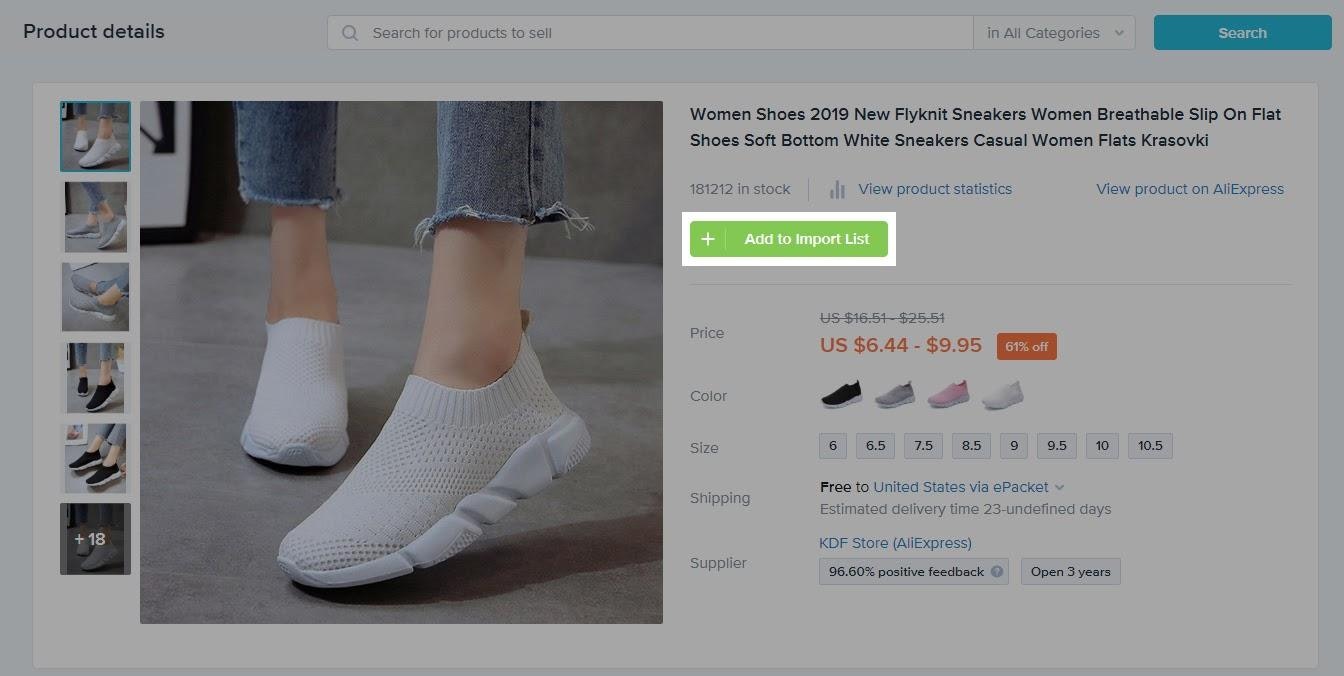
In AliExpress, click the blue Oberlo logo that shows up next to the product (we talked about this earlier).
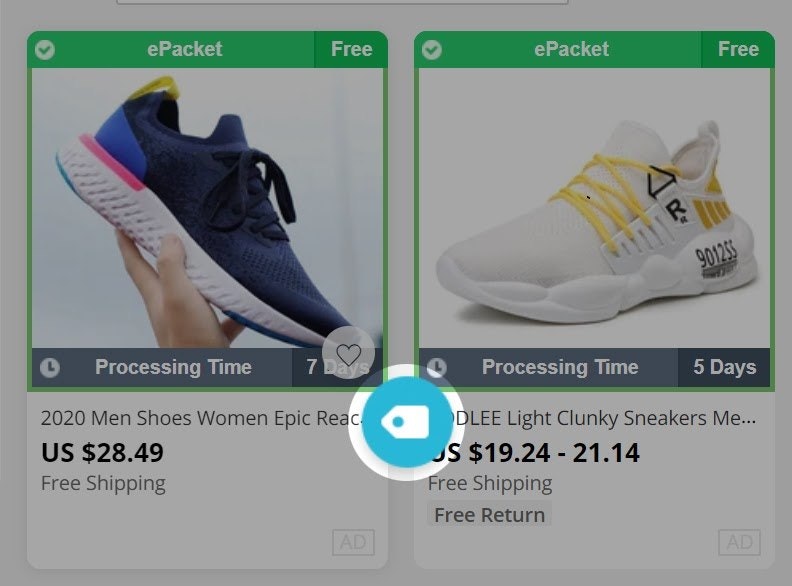
FYI, that same button shows up at the bottom right corner when you’re inside an AliExpress listing, too. It does the same thing there.
Once your list is populated, you can look at it by going to the left sidebar inside Oberlo.
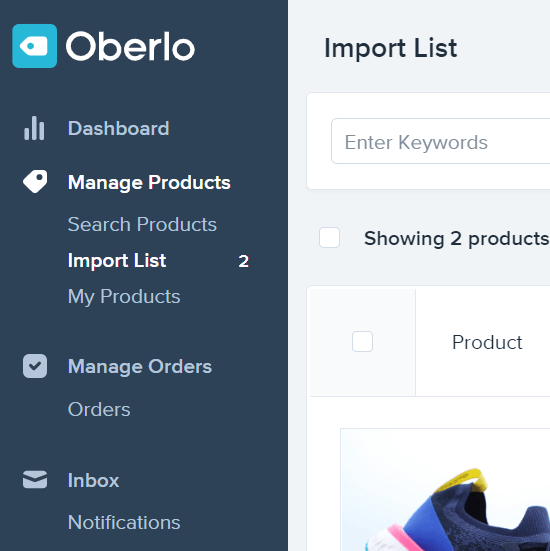
| 🕒 Tip Time
Adding products to your import list is the first step to getting them inside your Shopify store. Stay tuned for Chapter 5, where we’ll talk about how to customize each product and then add it into your store. |



3 Tips from the Pros
1. Use AliExpress reviews to gauge opportunity
Yuanda Wang shared a clever strategy with us. He looks at a supplier’s order history to determine if the supplier is dropshipping, or if the recent demand is organic from individual customers.
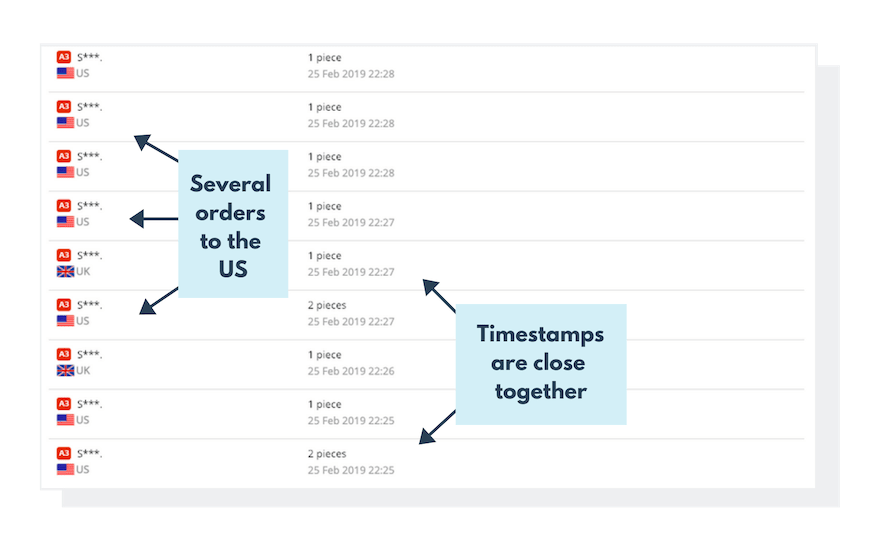
He then uses this intel to see if there’s a solid opportunity to capitalize on. He says:

“Before I started my store, I searched up the product on AliExpress, found a supplier, and I realized that there were a lot of organic purchases from people who actually are buying the product for themselves. They weren’t just one-off purchases, because in the order history, you can usually tell if someone is dropshipping. If there’s a string of names, they’re probably dropshipping, especially if it’s to the United States. And that’s one of the biggest criteria now that I look for in products: organic sales from people who use AliExpress as consumers and not dropshippers. Because that shows that there is a demand for the product, and in that exact moment, that supplier is not dropshipping heavily, so you have an opportunity to come in and get a slice of the pie.” |
2. Accept that your first products might not be your winners
Shishir and Namrata spent months testing products on Facebook Ads, adjusting their ads, and spending money without seeing significant returns. Altogether they tested around 20 to 30 products, spending about $50 to $100 per product to determine if it was a winner or not.
Although this might seem like a lot, it was money well spent. They were able to recoup those costs – and much more – when they found their first winning product.

“In the beginning, when you’re still looking for products, the number one thing would just be patience – having enough patience to test the products.” |
3. Use less suppliers so you can build strong relationships
When you use too many suppliers, there’s a lot more work you need to do to coordinate everything you need while keeping good relationships. Not to mention that it can be super stressful.
Andreas and Alexander told us that dropshippers are really missing out when they use too many suppliers. By limiting to only two suppliers and keeping a good relationship, they were able to get great info that they wouldn’t have known otherwise.

“We had 40 products in the first store from different suppliers. Big mistake. Now, we have two suppliers and a really good connection with them. It’s better to work like that because when we have a winning product and the connection with the supplier works well, I can talk to them and ask them what they’re selling that’s also very popular in their store. Then they can give us input. They know what that type of customer wants too, because they’re in the same niche.” |
👉 Now, you know how to choose awesome products from suppliers who will help your business. Next up is bringing your beautiful store to life.
